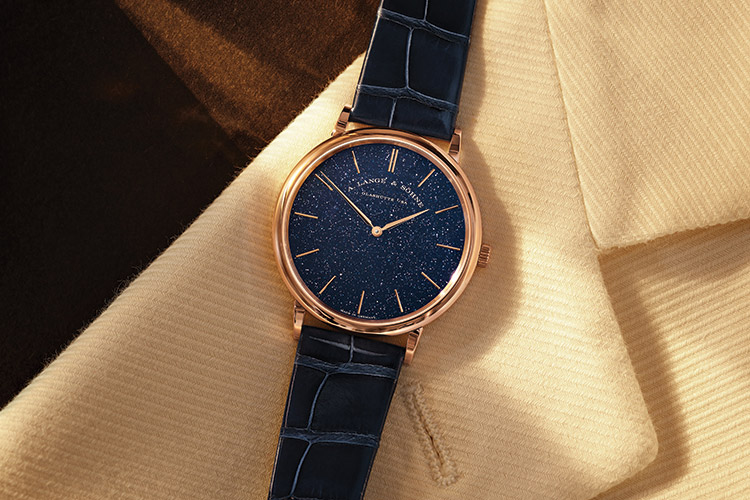
Haute horlogerie marque A. Lange & Söhne has unveiled three stunning horological complications; they include the Cabaret Tourbillon Handwerkskunst, the Langematik Perpetual, and the Saxonia Thin…
Cabaret Tourbillon Handwerkskunst
This limited 30-watch edition is a special version of the world’s first mechanical wristwatch with stop seconds for the tourbillon – the Cabaret Tourbillon – as presented by A. Lange & Söhne in 2008; with the Cabaret Tourbillon, it was possible to instantaneously stop the balance inside the rotating cage – and instantly restart it by pushing the crown home. Limited to 30 pieces, the new timepiece is the seventh of the Handwerkskunst series, characterised by elaborate finissage of dial and movement, with the lozenge as its signature design element.
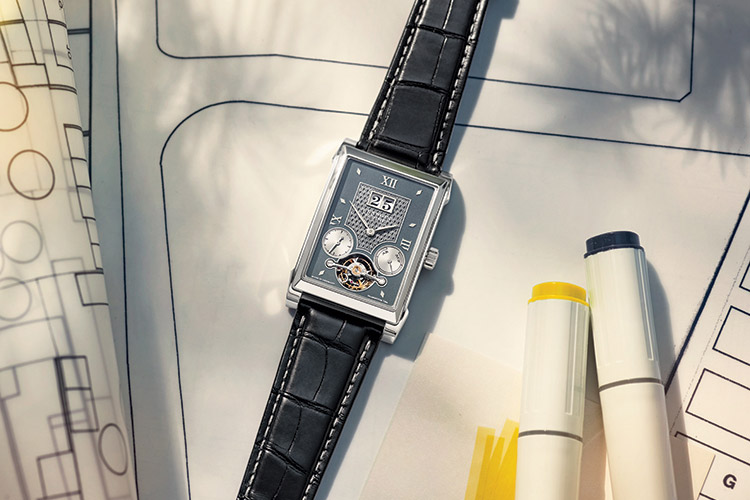
The three-part dial is of solid white gold crafted in the manufactory. The inner area with the Lange outsize date is manually engraved with a lozenge pattern, inspired by the six lozenge-shaped hour markers in gold that face the centre. A thin line decorated with tremblage visually separates the dial parts from one another. The dial is coated with a semi-transparent enamel layer, adding extra depth to the engraving. The result is an outstanding dial with a three-dimensional effect.
A rectangular case in platinum 29.5 X 39.2 mm forms the frame for this new tourbillon with a stop-seconds mechanism. It is graced with a deployant buckle in platinum and a black leather strap with grey contrast stitching.
The manually wound calibre L042.1 has a twin mainspring barrel that delivers a power reserve of 120 hours, and is composed of 370 parts, with 84 integrated in the filigreed tourbillon that weighs only a quarter of a gram. The movement owes its historic significance to a tiny component that transformed it into a milestone of precision watchmaking.
In 2008, more than 200 years after the invention of the tourbillon, A. Lange & Söhne showed how an oscillating balance inside the rotating cage can be stopped to set a tourbillon timepiece to the precise second. By pulling the crown, a complex lever mechanism is triggered that pivots a movable V-shaped spring onto the balance wheel rim. The balance stops instantaneously, even if one of the spring arms is in contact with one of the three cage posts. The special geometry of the spring assures that the pressure imposed on the balance is always correctly dosed, regardless of the position of the cage. It also preserves the potential energy of the balance spring so that the balance can restart instantly as soon as the arresting spring is retracted when the crown is pushed home.
In comparison with the 2008 version, it has a new indexless oscillation system with a Lange balance spring. The lozenge motif of the dial is echoed by the black-rhodiumed engravings on the tourbillon and intermediate wheel cocks, creating a visual bridge between the dial and the movement side. The engraved inscriptions on the plate are black-rhodiumed as well.
Langematik Perpetual
When the Langematik Perpetual was introduced in March 2001, it was the first and only self-winding watch with a perpetual calendar, Lange’s iconic outsize-date display, a Zero-Reset function and a main corrector for simultaneously advancing all calendar displays. On the occasion of its 20th birthday, it now comes in white gold or pink gold limited editions of 50 each.
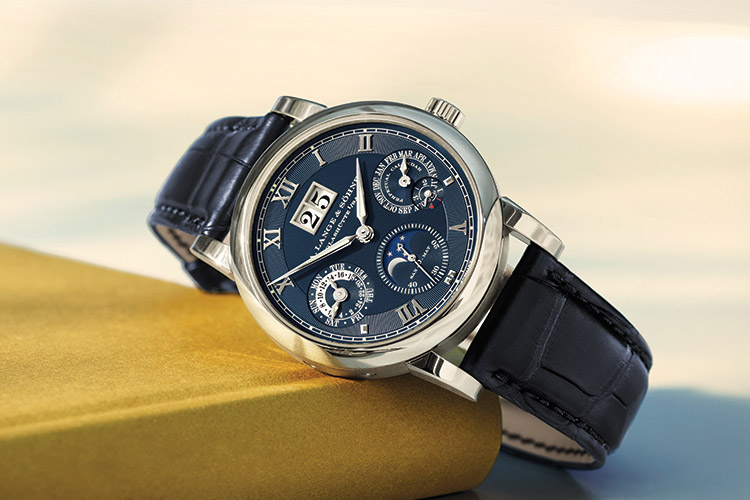
The blue dials of both new versions are crafted from solid silver. The applied Roman numerals, underlaid with an embossed groove structure, prominently stand out against the dark background. On the white-gold model, they are made of rhodiumed gold – just like the hands, appliques and lunar disc – and of pink gold on the pink-gold version. The hands for the hours, minutes, days of the week and month are luminous, as are the hour markers along the minute scale. A dark-blue leather strap with a prong buckle in white gold or pink gold complements the harmony of the timepiece.
The outsize date is prominently positioned. The subsidiary dial on the left shows the day of the week; the one on the right displays the month. The perpetual calendar takes into account the different durations of the months in a four-year cycle, including those of the leap years, and needs no manual adjustment until the year 2100. The moon-phase display at 6 o’clock, and the subsidiary seconds dial, is also a long-term indication, requiring a correction of one day every 122.6 years. All calendar displays can be advanced collectively with a (recessed) main corrector at 10 o’clock or can also be set separately.
The self-winding L922.1 Sax-0-Mat calibre features the Zero-Reset mechanism developed by Lange. When the crown is pulled, the balance wheel stops and the seconds hand jumps to the zero position. This simplifies and speeds up time setting. The bidirectionally winding rotor ensures that the maximum power reserve of 46 hours is attained within just a short time on the wrist. Integrated in the three-quarter plate, it consists of 21-carat gold with a centrifugal mass in platinum. This makes the escapement with hand-engraved balance cock and classic whiplash precision index adjuster readily visible.
Thanks to a movement height of merely 5.7 millimetres, the watch has a very slender silhouette. The case has a diameter of 38.5 millimetres and a height of just 10.2 millimetres.
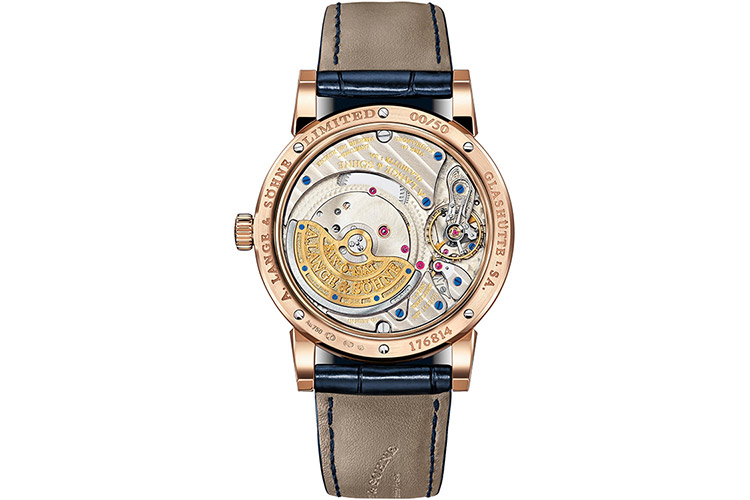
Saxonia Thin
The fascinating interplay of reflections on the blue copper-glittered face of the Saxonia Thin evokes images of a star-studded nocturnal sky. The solid-silver dial of the slender two-hand watch is coated with a thin layer of blue gold flux. Thousands of copper oxide crystals embedded in the material animate the deep blue hue with copper-coloured speckles that reflect incident light. They cause the surface to sparkle like a starry sky that will send the viewer into a reverie.
The elegant design of the Saxonia Thin follows the principle of “less is more”. Its 6.2-millimetre-high case in 18-carat pink gold has a diameter of 40 millimetres. Thanks to the characteristic camber of the strap lugs, the elegant watch ensures a perfectly snug fit on the wrist. The slender hour and minute hands as well as the applied hour markers are in pink gold to match the case material. The narrow bezel of the case puts the focus on the dial. A shiny, dark-blue leather strap with a solid-pink-gold prong buckle rounds out the elegant appearance of the watch.
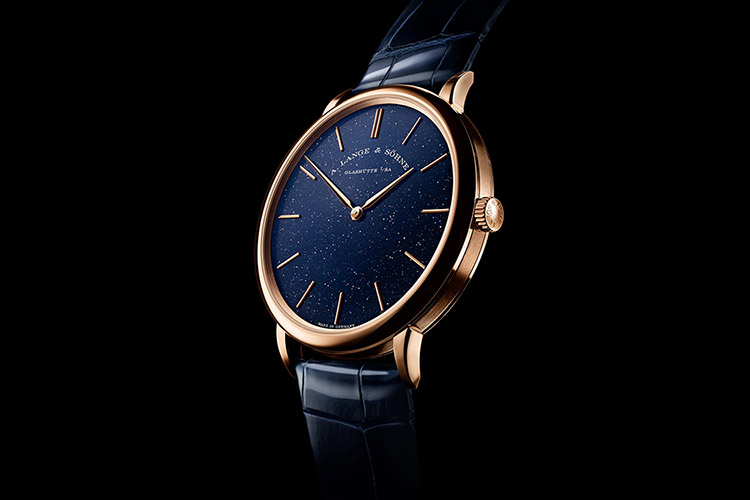
Inside is the manually wound calibre L093.1, a movement developed and crafted in-house. With a height of merely 2.9 millimetres, it is the manufactory’s thinnest calibre that provides a power reserve of 72 hours. The elaborately flat-polished end piece in which the escape wheel is secured is noteworthy. It is visibly integrated into the three-quarter plate as has often been the case in historic pocket watches. The chamfer of this flat steel part is matched to the chamfer of the three-quarter plate after it has been fitted by hand. As in pocket watches, the ratchet and crown wheels are decorated with solarisation and visibly integrated into the plate. The freely oscillating screw balance beats at a frequency of 21,600 semi-oscillations an hour. It is located beneath the hand-engraved balance cock. Three screwed, manually polished gold chatons hold the going train, reflecting the brand’s tradition in craftsmanship.






